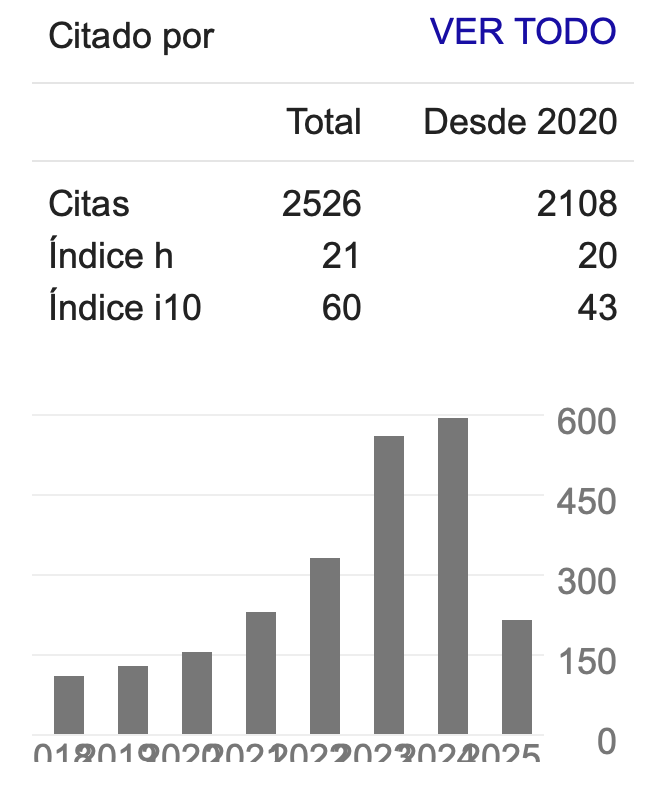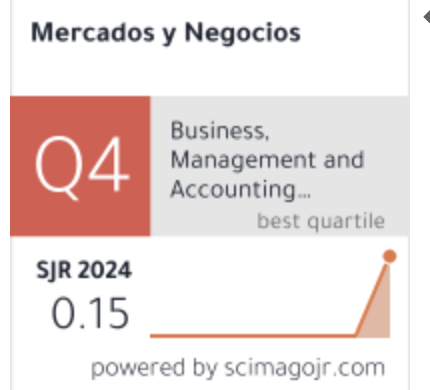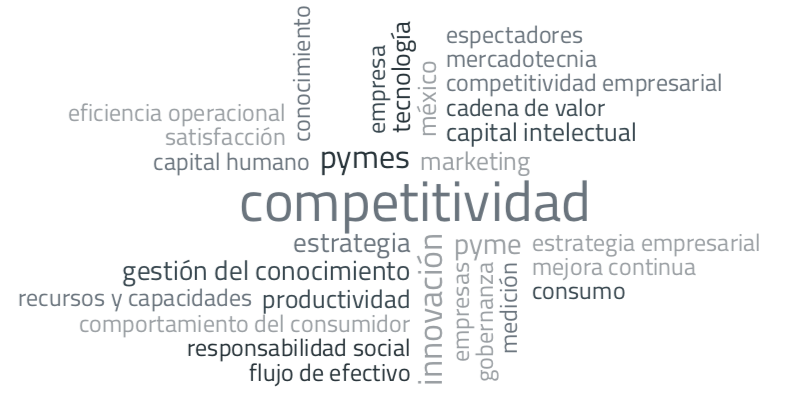Las capacidades de mercadotecnia como un factor de incide en la competitividad de los productores de flores en México
DOI:
https://doi.org/10.32870/myn.v0i26.5233Keywords:
competitividad, sector floricultor, recursos y capacidades, estrategias, mercadotecnia.Abstract
En México existe un enorme potencial del sector floricultor que desafortunadamente no se ha aprovechado: la privilegiada posición geográfica de México, su cercanía con Estados Unidos y Canadá, la variedad de climas y suelos propicios para la actividad; sin embargo, la oportunidad la han aprovechado otros países. El presente estudio empírico tiene como objetivo determinar en qué medida la calidad, la innovación, las capacidades gerenciales y de mercadotecnia inciden en la competitividad de los productores del sector floricultor del pueblo de San Andrés Totoltepec, Tlalpan. Para tal efecto se realizaron entrevistas y se aplicó un cuestionario. Dentro de los hallazgos se encontró que las capacidades de mercadotecnia y la competitividad presentan una correlación apreciable y más bien alta de 0.653, lo cual aporta evidencia empírica relacionada con la mercadotecnia como uno de los factores internos con mayor capacidad para generar competitividad (Ketchen, Hult y Slater, 2007; Kloter, 1994).References
Adell, R. (2007). Aprender marketing (Vol. 23). Grupo Planeta (GBS).
Amit, R., & Schoemaker, P. J. (1993). Strategic assets and organizational rent.Strategic management journal, 14(1), 33-46.
ANDREWS, K. R. (1971). La empresa y sus responsabilidades sociales: relacionar la estrategia corporativa con las necesidades de la sociedad. El concepto de Estrategia de la Empresa, 125-167.
Barney, J. B. (1986). Strategic factor markets: Expectations, luck, and business strategy. Management science, 32(10), 1231-1241.
Barney, J. (1991). Firm resources and sustained competitive advantage.Journal of management, 17(1), 99-120.
Benzing, C., Chu, H. M., & Kara, O. (2009). Entrepreneurs in Turkey: A factor analysis of motivations, success factors, and problems. Journal of small business management, 47(1), 58-91.
Bibu, N. A., Sala, D., Pantea, M., & Bizoi, G. (2008). Considerations about the Influence Factors on the Competitiveness of SME's from Western Region of Romania. Available at SSRN 1156397.
Chandler, A. D. (1992). Organizational capabilities and the economic history of the industrial enterprise. The Journal of Economic Perspectives, 6(3), 79-100.
Pag181
Čirjevskis, A., Kubilute, L., Ershovs, S., & Medvedevs, V. (2009). INNOVATIVE BUSINESS AND NEW INDUSTRIAL TECHNOLOGIES AS POSSIBLE DRIVERS OF THE SME'S COMPANIES GROWTH IN A CONDITION OF ECONOMIC RECESSION. Journal of Business Management, (2).
Coy, S. P., Shipley, M. F., Omer, K., & Khan, R. N. A. (2007). Factors contributory to success: A study of Pakistan's small business owners. Journal of Developmental Entrepreneurship, 12(02), 181-198.
Day, G. S. (1994). The capabilities of market-driven organizations. the Journal of Marketing, 37-52.
García, J. E., Blasco, O. B., & Serrano, V. C. (2005). ¿ Competitividad e innovación en la micro y pequeña empresa?. Estudios de economía aplicada,23(3), 559-582.
Grant, R. M. (1991). The resource-based theory of competitive advantage: implications for strategy formulation. California management review, 33(3), 114-135.
Hall, R. (1992). The strategic analysis of intangible resources. Strategic management journal, 13(2), 135-144.
Hernández, M. E. O., & Martínez, M. M. (2003). Competitividad local de la agricultura ornamental en México. Ciencia Ergo Sum, 10(1).
Jaime, R. C., & Mencía, D. G. (2012). Dirección de Marketing, fundamentos y aplicaciones. Madrid.
Ketchen, D. J., Hult, G. T. M., & Slater, S. F. (2007). Toward greater understanding of market orientation and the resource‐based view. Strategic Management Journal, 28(9), 961-964.
Kotler, P. (1994). Analysis, planning, implementation and control. Prentice Hall International.
Kotler, P., & Armstrong, G. (2008). Fundamentos de Marketing.(en español; Mónica Gabriela Martínez Gay, trad.).
Kourounakis, N., & Katsioloudes, M. (2009). Characteristics of Greek SMEs: Motivation for Business Ownership, Success Factors and Problems. InProceedings of the European Conference on Management, Leadership & Governance (Vol. 1, No. 1, pp. 175-183).
Lahura, E. (2003). El coeficiente de correlación y correlaciones espúreas (Vol. 218). Pontificia Universidad Católica del Perú, Departmento de Economía.
Lu, W., Shen, L., & Yam, M. C. (2008). Critical success factors for competitiveness of contractors: China study. Journal of construction engineering and management, 134(12), 972-982.
Luk, T. K. (1996). Success in Hong Kong: Factors self-reported by successful small business owners. Journal of Small Business Management, 34(3), 68.
Méndez Álvarez, C. (2006). Metodología: Diseño y desarrollo del proceso de investigación con énfasis en ciencias empresariales. Editorial Limusa.
Morales, R. (2004). Hacia un presupuesto participativo. La experiencia en Tlalpan, Distrito Federal. Participación ciudadana y políticas sociales en el ámbito local. México: UNAM-Instituto de Investigaciones Sociales/Consejo Mexicano de Ciencias Sociales/Instituto Nacional de Desarrollo Social, 431-442.
Moran, F. (2004). Producción de plantas ornamentales en invernadero. InMemorias del IV Simposio Nacional de Horticultura.
Narver, J. C., & Slater, S. F. (1990). The effect of a market orientation on business profitability. The Journal of marketing, 20-35.
Parhizkar, O., Smith, R. B. L., & Miller, C. R. (2009). Comparison of important competitiveness factors for small-to medium-sized forest enterprises. Forest products journal, 59(5), 81.
Pelham, A. M. (2000). Market orientation and other potential influences on performance in small and medium-sized manufacturing firms. Journal of small business management, 38(1), 48.
Penrose, E. T. (1959). The theory of the growth ofthe firm. New York: Sharpe.
Percheron, N. (2008). Problemas agrarios del Ajusco. Siete comunidades agrarias de la periferia de México.
Porter, M. E. (1980). Competitive strategy-techniques for analysis industries and competitors. New York: The Free Press. Quchi, WG (1979). A Conceptual Framework for the Design of Organizational Control mechanism. Management Science, 25(9), 833-848.
Rogoff, E. G., Lee, M. S., & Suh, D. C. (2004). “Who done it?” Attributions by entrepreneurs and experts of the factors that cause and impede small business success. Journal of Small Business Management, 42(4), 364-376.
Rumelt, R. P. (1991). How much does industry matter?. Strategic management journal, 12(3), 167-185.
Sainz, J. M. (2008). El plan de marketing en la práctica. Esic Editorial.
Schneer, M. (1997). Marketing de servicios profesionales: construyendo la práctica profesional. Ediciones Granica SA.
Zornoza, C. C. (1997). La competitividad de la PYME industrial española: estrategia y competencias distintivas.
Downloads
Published
How to Cite
Issue
Section
License
Mercados y Negocios by Department of Mercadotecnia y Negocios Internacionales. University of Guadalajara is licensed under a License Creative Commons Attribution-NonCommercial 4.0 International.
The author retains the copyright.








